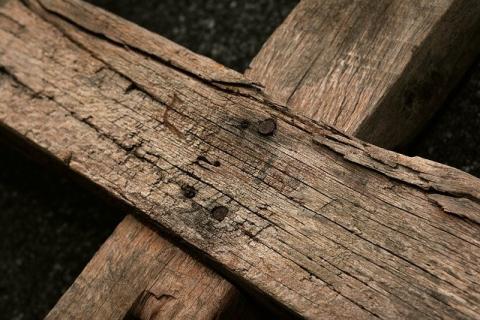Cross of Knowledge of Good & Evil

The central tenet of Christianity is the atoning death of Jesus Christ upon the cross. This object was made from a couple of crude, wooden beams which were fastened together, either in a traditional cross shape, or a T, to cruelly accommodate the victim’s outstretched arms and legs. Occasionally, the scriptures refer to this instrument of death as being a ‘tree’. Peter, in 1:2:24, for example:
who Himself bore our sins in His own body on the tree, that we, having died to sins, might live for righteousness—by whose stripes you were healed. (NKJV)
Also Paul, in Galatians 3:13-14, quotes the Torah’s grim pronouncement:
Christ redeemed us from the curse of the law by becoming a curse for us—for it is written, “Cursed is everyone who is hanged on a tree”— so that in Christ Jesus the blessing of Abraham might come to the Gentiles, so that we might receive the promised Spirit through faith. (ESV)
It is strange that tree should be used for something that might have come from a tree, but was no longer such. I have a wooden wardrobe at home; I do not tell myself that I am returning a suit 'to the tree'. When I sit on one of my wooden dining chairs, I do not consider myself to be occupying a branch. The wood once grew, but its time in the forest came to an end.
I would propose that both Peter, Paul and Moses all refer to 'the tree' because they are alluding to the Garden of Eden. There, many trees grew, including the Tree of Life and the Tree of the Knowledge of Good and Evil. The first was forbidden to us before the Fall, the second, afterwards. Having taken the former’s fruit in an act of rebellion against God, our parents were shamed by their nakedness. They stood out, exposed as rebels and uncovered as cheats. Henceforth, they would be exiled from paradise, they and their billions of children with them.
According to God’s sovereign plan, Jesus the promised Messiah would die to atone for this terrible act- and all the ones that stem therefrom. The cross is a picture of that tree; it might be said that He was nailed to the Tree of Knowledge of Good and Evil. It was not the same, literal specimen as that one found in Eden; if it had not died when the ground was cursed, Noah’s flood would have swept it well away. No, metaphorically that tree was cut down and sawn into planks that the Second Adam might also partake of it; not, this time, enjoying its juicy fruits, but suffering its terrible curse. Christ ‘became sin for us’ while crucified upon it.
As a Justice of the Peace, I am sometimes required to pronounce verdict and sentence offenders:
“John Smith, we find you guilty of the charge of burglary…”
“John Smith, having been found guilty of burglary, we sentence you to 16 weeks’ custody…”
I wonder if, while the Lord Jesus was nailed to that tree, the verdict and sentence of every sin was pronounced against Him:
“Jesus Christ, you are found guilty of theft/murder/lust/bitterness/idolatry/adultery/cruelty/gossip/blasphemy/pride/hypocrisy/greed…”
Imagine the infinite roll-call of guilty verdicts screaming in His sacred ears! And for each one, the dreadful sentence:
“Death! Death! Death! Death! Death!...”
Just imagine the innumerable charges, verdicts and death-sentences booming at Him as He bore the very scum of human rebellion, horribly caked in our filth, splattered and stained by our iniquity. Even those who believe in a limited atonement (that Christ only bore the sins of believers rather than the sins of everyone) must marvel at the sheer weight of the convictions and verdicts He carried. If that Tree had given Adam a sense of his own shame and rebellion, it gave to Christ the sense of shame and guilt of many generations of fallen thoughts, words and deeds. Whereas Adam’s fall corrupted him so he eventually revelled in his shame and justified his evil, Christ’s crucifixion truly exposed sin’s dreadful horrors. Charles Wesley, naturally, says it better than most in his hymn O Love Divine, What Hast Thou Done:
O Love divine, what hast thou done!
The immortal God hath died for me!
The Father's co-eternal Son
Bore all my sins upon the tree.
Th'immortal God for me hath died:
My Lord, my Love, is crucified!
Is crucified for me and you,
To bring us rebels back to God.
Believe, believe the record true,
Ye all are bought with Jesus' blood.
Pardon for all flows from His side:
My Lord, my Love, is crucified!
Behold and love, ye that pass by,
The bleeding Prince of life and peace!
Come, sinners, see your Saviour die,
And say, "Was ever grief like His?"
Come, feel with me His blood applied:
My Lord, my Love, is crucified!
The fourth verse, however, invites us to sit beneath the cross. The real cross would have been a grim, bloody object, something to avoid and from which to avert one’s gaze. Yet truly, the Crucified Messiah renders the cruel cross into the very Tree of Life, which binds our wounds and heals the nations:
Then let us sit beneath His cross,
And gladly catch the healing stream:
All things for Him account but loss,
And give up all our hearts to Him:
Of nothing think or speak beside,
My Lord, my Love, is crucified!
Christ stood in the dock of justice and pleaded guilty to every evil you have commissioned. He answered the charge, He bore the sentence. To we who believe, the fruits of Eden are once more available, freely offered to all who will come:
“Blessed are those who wash their robes, that they may have the right to the tree of life and may go through the gates into the city.” Rev 22:14
Image by congerdesign from Pixabay
- Log in to post comments


 Sunday Worship 10.45am & 6.00pm
Sunday Worship 10.45am & 6.00pm